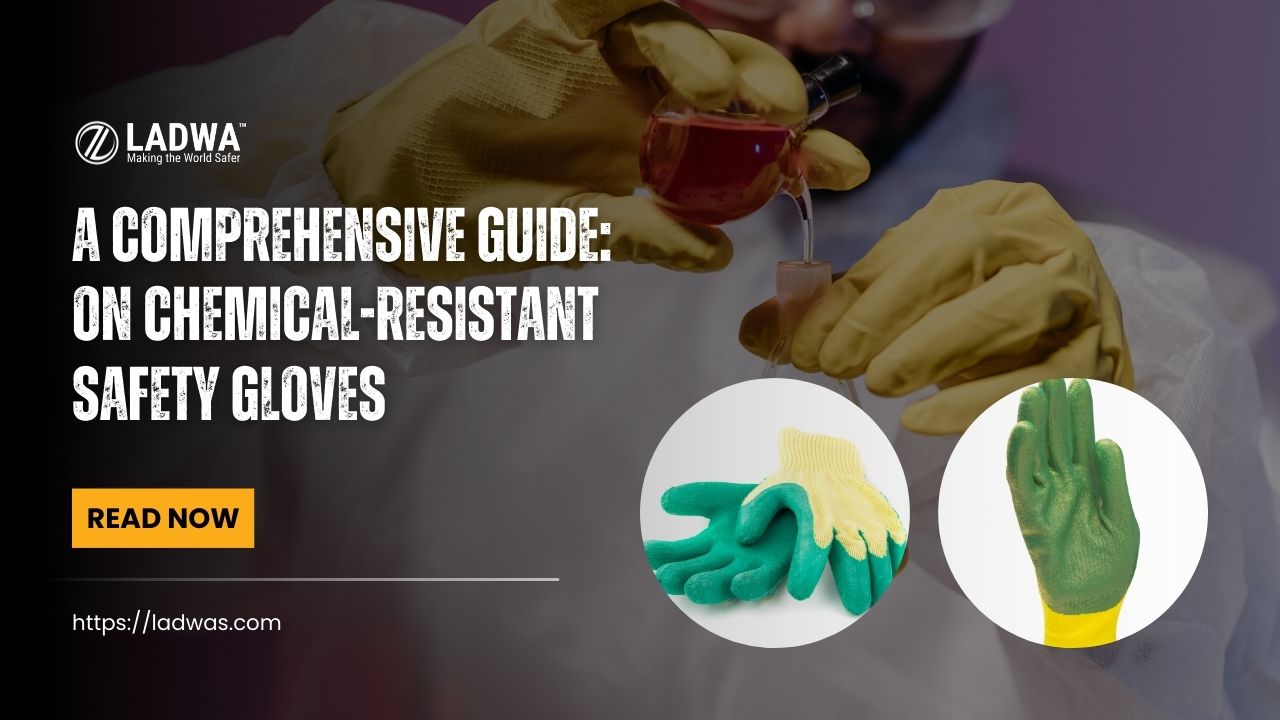What are Chemical-Resistant Safety Gloves?
Chemical-resistant safety gloves are protective gloves designed to shield the hands from exposure to hazardous chemicals, solvents, and other harmful substances. These gloves are manufactured using various materials that provide a barrier against chemical permeation, degradation, and absorption.
The primary purpose of chemical-resistant gloves is to protect workers who handle chemicals in industrial settings, laboratories, healthcare facilities, or any environment where there is a risk of chemical exposure. These safety gloves are essential for preventing skin contact with corrosive, toxic, or irritant chemicals, which can lead to burns, skin irritation, or even absorption into the bloodstream. The most widely used standard for defining the protective qualities of chemical-resistant gloves is EN ISO 374.
The factors that define the protective quality of a safety glove are its resistance to permeation, penetration, and degradation by the chemicals the worker is at risk of being exposed to. Employers must take care to verify that the specific form of chemical protection offered by a glove is suitable for the chemicals to which the employee is exposed.

When it comes to chemical-resistant gloves, one size does not fit all. Different materials offer unique levels of protection, and understanding their specific advantages and disadvantages is critical. The most common materials for chemical-resistant gloves include:
- Nitrile: A synthetic rubber that provides excellent chemical resistance and puncture protection. Nitrile gloves are ideal for workers with latex allergies, as they’re latex-free. However, they may not offer the same level of tactile sensitivity as latex gloves.
- Latex: Derived from natural rubber, latex gloves offer excellent dexterity and a comfortable fit. They’re suitable for a wide range of applications, but may not be the best choice for those with latex allergies or sensitivity.
- Neoprene: A synthetic rubber known for its resistance to a broad range of chemicals, including acids, alkalis, and solvents. Neoprene gloves provide a high level of protection, but they can be less flexible than other materials.
- PVC (Polyvinyl Chloride): A cost-effective option, PVC gloves are resistant to many chemicals and offer decent abrasion resistance. However, they may not be the most comfortable option due to their stiffness.
It is important to note that no single glove material is resistant to all chemicals, and the selection of the appropriate glove depends on the specific chemicals being handled and the level of protection required. Manufacturers provide chemical resistance charts to help users choose the right glove for their application.

Understanding Chemical Resistance in Gloves
To make informed decisions about choosing and using chemical-resistant safety gloves, it is important to understand the two primary mechanisms that govern their effectiveness: permeation and degradation.
- Permeation :- is the process by which chemicals seep through the glove material at the molecular level. Glove materials with low permeation rates are more effective at preventing chemicals from reaching the wearer’s skin.
- Degradation :- occurs when a chemical compromises the glove’s structural integrity, causing it to weaken, swell, or even disintegrate. Degraded gloves may become less resistant to chemicals and offer reduced protection.
Permeation and degradation can occur simultaneously, and their combined effects can determine how long a glove remains effective in protecting the wearer from chemicals.

A number of factors can affect the permeation and degradation of chemical-resistant gloves, including:
- The type of glove material
- The thickness of the glove material
- The temperature and pressure of the environment
- The type of chemical being handled
- The concentration of the chemical
- The duration of exposure to the chemical
Considering factors such as thickness, dexterity, and tactility is crucial when selecting chemical-resistant safety gloves for workers. Thicker gloves may provide better protection against permeation but may not offer the same level of dexterity or tactility. Striking a balance between protection and performance is key to ensuring workers can efficiently complete tasks without compromising safety.

Chemical-resistant gloves are indispensable across various industries, including healthcare, manufacturing, and building services. Let’s delve into specific tasks within each industry that necessitate the use of these gloves:
- Healthcare: Professionals working with hazardous chemicals, such as disinfectants or chemotherapy drugs, must don chemical-resistant gloves to prevent skin irritation or absorption of harmful substances. Gloves can also protect against bloodborne pathogens and other infectious materials.
- Manufacturing/Distribution: Workers handling chemicals, solvents, or corrosive substances require appropriate gloves to prevent chemical burns, irritation, and potential long-term health issues. Additionally, gloves can protect against cuts and abrasions during material handling.
- Building Services: Maintenance personnel, janitorial staff, and cleaning professionals often work with cleaning chemicals, solvents, or degreasers, making chemical-resistant gloves a crucial part of their safety gear.
Not using appropriate safety gloves in these industries can result in severe consequences, including chemical burns, skin irritation, or even long-term health issues. By understanding the specific needs and risks within each industry, workers can choose the right gloves to ensure optimal protection.

Selecting the perfect chemical-resistant safety gloves involves careful consideration of several factors. Keep the following tips in mind when making your decision:
- Chemical Compatibility: Consult compatibility charts and guidelines to ensure the glove material you choose is resistant to the specific chemicals you’ll be handling.
- Material Type: Weigh the pros and cons of each glove material (nitrile, latex, neoprene, PVC) to determine which one best suits your needs in terms of protection, dexterity, and comfort.
- Glove Size and Fit: Properly fitting gloves are essential for both safety and comfort. Gloves that are too tight can limit dexterity and cause hand fatigue, while gloves that are too loose can reduce grip and control.
- Work Environment and User Comfort: Consider the conditions in your workplace, such as temperature and humidity levels. Some glove materials may be more comfortable and provide better grip in specific environments.
- Industry Standards and Certifications: Look for safety gloves that meet relevant industry standards and certifications, such as those set by the Occupational Safety and Health Administration (OSHA) or the American National Standards Institute (ANSI).
How to Use and Maintain Chemical-Resistant Gloves?
To ensure optimal protection from chemicals, it is important to know how to properly wear, care for, and dispose of chemical-resistant gloves. Here are some tips:
Wearing and Removing Gloves
- Put on your gloves carefully, making sure they fit snugly but comfortably.
- To remove your safety gloves, avoid touching the contaminated exterior. Instead, grasp the cuff of one glove with the other hand and peel it off, then use the clean interior of the removed glove to take off the other.
Inspecting Gloves
- Before each use, inspect your gloves for signs of wear, tear, or damage. If you notice any issues, replace the chemical resistant gloves immediately.
Cleaning, Storing, and Disposing
- Clean reusable gloves according to the manufacturer’s instructions.
- Store gloves in a cool, dry place away from direct sunlight.
- Dispose of single-use gloves in accordance with your organization’s waste disposal protocols and local regulations.
Replacing Gloves
- Regularly replacing gloves is essential for maintaining their effectiveness.
By following these guidelines, you can maximize the life and effectiveness of your chemical-resistant gloves, ensuring your hands remain protected and your work environment remains safe.


Adhering to key regulations and standards governing the use of chemical-resistant gloves is crucial for ensuring workers’ safety and maintaining compliance. The following organizations set guidelines and requirements for glove selection and use:
- OSHA (Occupational Safety and Health Administration): OSHA enforces regulations related to workplace safety, including the use of personal protective equipment (PPE) like chemical-resistant gloves. OSHA’s 29 CFR 1910.138 standard mandates that employers provide appropriate hand protection when employees’ hands are exposed to hazards.
- ANSI (American National Standards Institute): ANSI/ISEA 105-2016 is a voluntary consensus standard that establishes performance classifications for gloves regarding their resistance to various hazards, including chemicals.
Compliance with these regulations is not only crucial for worker safety but also essential for businesses and organizations to avoid fines, litigation, and reputational damage. Stay updated on relevant regulatory requirements and ensure your chemical-resistant gloves meet these standards.

Chemical-resistant gloves play an indispensable role in safeguarding workers across various industries, ensuring their safety and well-being. By carefully considering the factors discussed in this guide, you can select the right safety gloves that offer the optimal balance of protection, comfort, and performance. Remember, investing in high-quality, reliable safety gloves for worker is not only a smart decision but also a crucial step toward ensuring peace of mind and a safer work environment.








